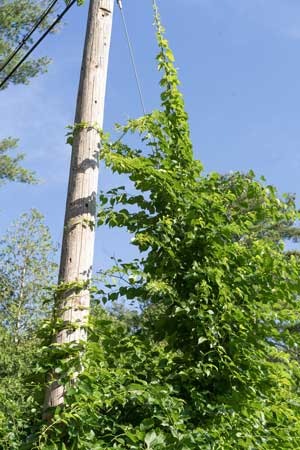by Margaret Kusner ·
Friday, June 28, 2024
Tuesday evening at the library, 89 people attended a talk, “Managing Backyard Invasives,” given by Jane Maloney, a land steward with the Sudbury Valley Trustees. The presentation introduced “Clearing Invasive Harvard Plants,” or CLIHP, a project of the Harvard Conservation Commission and Climate Initiative Committee that encourages citizens to tackle the problem of invasives on their own properties.

Asiatic bittersweet, a climbing vine, will wrap around just about anything—a tree, a bush, a fencepost, or even a mailbox. (Photo by Lisa Aciukewicz)
Invasive plants, as opposed to native and non-native plants, are from a different area but spread freely and degrade wildlife habitat. They thrive through a lack of predators, a tolerance for a variety of growing conditions, and an ability to spread quickly, replacing native plants. In some cases, they alter the soil chemistry to the detriment of the local ecosystem.
The most decisive factors that harm native plants and create favorable conditions for invasives are disturbances to the landscape and climate change, Maloney said. And native wildlife suffers for it as non-native plants replace the preferred food of birds and pollinators. As non-native plants and trees spread, even the height of trees the birds normally nest and perch on changes, affecting the availability of the light and water they need to thrive.
Managing the impact of invasive species on the landscape is expensive and laborious, so the efforts of homeowners are needed, Maloney said.
The first step is to identify the invasives. The plants that local landowners and caretakers need to be aware of and remove, Maloney said, are:
- Asiatic bittersweet
- Japanese knotweed
- multiflora rose
- burning bush
- garlic mustard
- glossy buckthorn
- Japanese barberry
- tree of heaven
- amur corktree
The second step is to remove them or control their spread—especially onto neighboring woodlands, where they can take hold without anyone noticing right away. Eradicating or reducing invasives may involve manual or mechanical removal; herbicide treatment; introduction of plant-eating creatures such as goats or insects; or smothering invasives with cardboard or plastic. Maloney often mentioned that an effective removal technique for many invasive plants was cutting the plant down and painting the cut surface with herbicide.
Then comes disposal, which Maloney said must be done with care. During the question-and- answer period, she suggested leaving the extracted or clipped plant material on-site to dry out and then burning it. Or, putting it in a separate compost pile or disposing of it in a sealed trash bag.
As for replanting with native species, Maloney told the audience that it was OK to start putting in new native plants even as you are still clearing invasive plants. She said to lightly put in new plants to compete with the invasives as you clear; members of the audience experienced in dealing with invasives agreed that replanting as you clear can work.
Eve Wittenberg of the Conservation Commision reminded the audience to be “sufficiently cautious in the presence of wetlands,” as the Harvard Conservation Commission has jurisdiction within 100 feet of wetlands. However the commision is there to help in the effort to eradicate invasives, she said.
A resource center at Hildreth House, where conservation agent Liz Allard has an office, offers free books on the topic, tools for invasive removal, and native seeds.